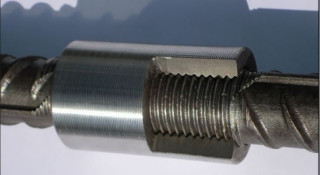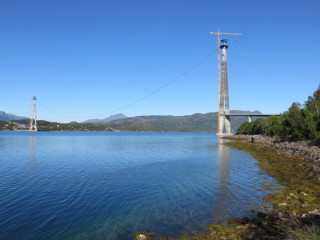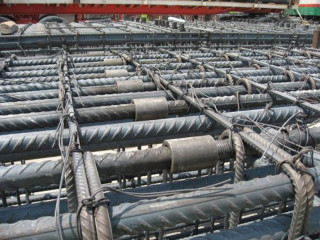The failure of structural fixings can have disastrous, even tragic consequences – at the very least, the need for expensive and time-consuming repairs; at worst, loss of life. While recently-published industry guidance is intended to improve management and design of critical fixings, and raise awareness of potential risks, high-profile cases continue to hit the headlines.
In Norway, all 344 anchor bolts holding down the main suspension cables on the 1.5km-long Chinese-built Hålogaland Bridge (below) are currently being replaced after hydrogen-induced cracks were found in some of them within a month of the bridge opening last December. The cost of the replacement work has been estimated as anything up to £8m, but could be more, according to the Norwegian Public Roads Administration.
Potential problems with reinforcement couplers were discovered last year on Hong Kong’s Hung Hom Station extension construction on the Shatin to Central Link railway project, and a major inquiry into the circumstances is still under way, with the construction project at a standstill.
The remit of the inquiry commission was expanded after new revelations about oversight and construction standards on the project came to light earlier this year. New construction is now being broken out so the existing couplers can be examined, to try and establish the extent of the problem.

“One of the main reasons, particularly for bolts and fixings, is that they are right at the bottom of the purchasing chain, and it often comes down to the cheapest products that the purchaser can find,” explains Soane.
“Designers don’t spend enough time considering and specifying these items, or if they do, the products that are ultimately purchased and installed may not meet the required specifications.” Soane notes the need for robustness in such systems, with sufficient redundancy provided to reduce the risk of progressive collapse, and recommends that independent examination of the fixings be provided at the site. “Fixings deserve the full attention of those designing and installing them,” he says.
A recent report to CROSS, details of which were published in its July newsletter, highlighted how a large number of defective reinforcement bars could easily have found their way onto a project undetected. In this case, a quarter of all threaded reinforcement bars delivered to a site in the UK for coupling were found to have visibly different tapered threads cut into them.
The length of threaded section, and the depth and pitch of the threads themselves, varied between bars of the same diameter. Both the reinforcement and coupler manufacturers inspected the bars on site and confirmed that they were unlikely to be capable of providing the required tensile capacity once connected.
But the problem could quite easily have gone undetected; it is common for bars to be delivered to site with the couplers already installed, and in this case the threads would not be visible and the manufacturer’s quality control systems would be relied on to identify any potential problems.
Quality control systems were in place for the production of the bars, including the cutting of the threads, which was carried out by the reinforcement manufacturer using equipment supplied by the coupler manufacturer. Thread gauges were used to check one in every ten bars.
Investigations confirmed that the machine was working properly and in fact the cause of the defects was found to be down to machine operator error. All of the threaded bars from the delivery were tested and more than a quarter of them were found to have defects – thread cut too short, thread cut too long, incorrect thread pitch and non-contiguous threads cut into bars leaving a considerable surface area of bar unthreaded.
CROSS commented on the implications if the defects had not been spotted: if they had been cast in, then safety would have been compromised; and if the defects were discovered during or after construction, remedial costs and delays could have been huge.
“The construction industry relies on products meeting defined standards, and the onus is on the supplier to ensure such standards are met,” the CROSS response stated. “However...it is essential to have adequate supervision and inspection of work on site”.

The report did not reveal whether the reinforcement and mechanical couplers were specified as having to be certified by CARES, the UK Certification Authority for Reinforcing Steels, nor whether the supplier/fabricator had the appropriate certification under the same scheme.
Independent third-party certification of safety- critical components by an accredited body has long been acknowledged as vital for safety, and was one of the main recommendations of the post-Grenfell Hackitt report Building a safer future - Independent Review of Building Regulations and Fire Safety.
But even certified suppliers should be operating continuous improvement processes based on such reports.
The risks inherent in poor design and installation of safety-critical fixings were also acknowledged by the publication of free guidance by the Construction Industry Research & Information Association (CIRIA) earlier this year. Management of safety-critical fixings provides practical guidance for the management and design of bolts, couplers, anchors and other fixings, and highlights how good design and installation can minimise risk.
The guidance was developed in partnership with Highways England, whose head of structures policy, Neil Loudon, says in the foreword that the publication will plug a significant gap in guidance. “If in doubt, look up at the office suspended ceiling above, and consider how it is supported,” he suggests.

A costly failure
When huge bolts started to fall off the Cheesegrater in November 2014, just months after construction work ended, the legal battles began. Four-and-a-half years later, in April this year, the affair was finally settled.
Structural steelwork contractor Severfield revealed in a trading update to shareholders that: “Following extensive negotiations with all stakeholders, we have now agreed a final settlement for the remedial bolt replacement works at Leadenhall, resulting in no further costs for the group.”
In its 2015 accounts Severfield wrote off £6m for the costs of the bolt replacement work, in advance of any legal settlement.
The 47-storey Cheesegrater, officially called The Leadenhall Building, is at 122 Leadenhall Street in the City of London. It was built by Laing O’Rourke for developer British Land, with Arup as structural engineer and Severfield as structural steelwork subcontractor.
Even during construction, Severfield had technical problems, losing £10m on the initial project and costing chief executive Tom Haughey his job. Further costs were incurred when bolts began falling off the 238m-high skyscraper in November 2014. Luckily, nobody was injured by the falling steelwork.
Tests found that bolts were fracturing due to hydrogen embrittlement, a material failure mechanism within the bolt material. The subsequent bolt replacement programme took the best part of a year in 2015 but the dispute about liability continued.
Got a story? Email news@theconstructionindex.co.uk



